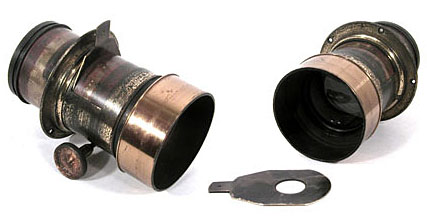In optics, aberration is a property of optical systems such as lenses that causes light to be spread out over some region of space rather than focused to a point. Aberrations cause the image formed by a lens to be blurred or distorted, with the nature of the distortion depending on the type of aberration. Aberration can be defined as a departure of the performance of an optical system from the predictions of paraxial optics. In an imaging system, it occurs when light from one point of an object does not converge into a single point after transmission through the system. Aberrations occur because the simple paraxial theory is not a completely accurate model of the effect of an optical system on light, rather than due to flaws in the optical elements.
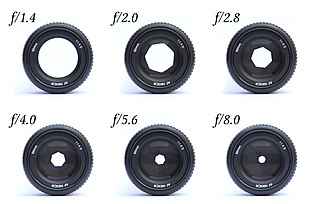
In optics, an aperture is a hole or an opening through which light travels. More specifically, the aperture and focal length of an optical system determine the cone angle of a bundle of rays that come to a focus in the image plane.

A camera is an optical instrument used to capture an image. At their most basic, cameras are sealed boxes with a small hole that allow light in to capture an image on a light-sensitive surface. Cameras have various mechanisms to control how the light falls onto the light-sensitive surface. Lenses focus the light entering the camera, the size of the aperture can be widened or narrowed to let more or less light into the camera, and a shutter mechanism determines the amount of time the photo-sensitive surface is exposed to the light.

A pinhole camera is a simple camera without a lens but with a tiny aperture —effectively a light-proof box with a small hole in one side. Light from a scene passes through the aperture and projects an inverted image on the opposite side of the box, which is known as the camera obscura effect.

In A World History of Photography, Naomi Rosenblum states that a view camera is: "A large-format camera in which the lens forms an inverted image on a ground glass screen directly at the plane of the film. The image viewed is exactly the same as the image on the film, which replaces the viewing screen during exposure." However, Rosenblum didn't give size limits for "large format"; and the book includes view camera formats smaller than 4x5, which are commonly seen as the smallest of the large format cameras.

A twin-lens reflex camera (TLR) is a type of camera with two objective lenses of the same focal length. One of the lenses is the photographic objective or "taking lens", while the other is used for the viewfinder system, which is usually viewed from above at waist level.
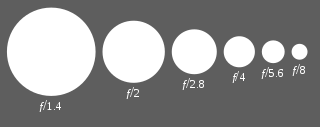
In optics, the f-number of an optical system such as a camera lens is the ratio of the system's focal length to the diameter of the entrance pupil. It is also known as the focal ratio, f-ratio, or f-stop, and is very important in photography. It is a dimensionless number that is a quantitative measure of lens speed; increasing the f-number is referred to as stopping down. The f-number is commonly indicated using a lower-case hooked f with the format f/N, where N is the f-number.
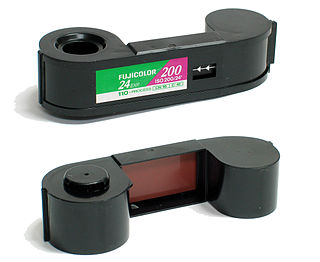
110 is a cartridge-based film format used in still photography. It was introduced by Kodak in 1972. 110 is essentially a miniaturized version of Kodak's earlier 126 film format. Each frame is 13 mm × 17 mm, with one registration hole. Cartridges with 12, 20, or 24 frames are available on-line. Production variations sometimes have allowed for an additional image.

A camera lens is an optical lens or assembly of lenses used in conjunction with a camera body and mechanism to make images of objects either on photographic film or on other media capable of storing an image chemically or electronically.

The Holga is a medium format 120 film camera, made in Hong Kong, known for its low-fidelity aesthetic.

The Diana camera is a plastic-bodied toy camera using 120 rollfilm and 35 mm film. The camera has a simple plastic meniscus lens. Originally marketed as an inexpensive novelty gift item, the Diana has been used to specifically take soft focus, impressionistic photographs somewhat reminiscent of the Pictorialist Period of artistic photography, branded in contemporary times as lomography.

An apochromat, or apochromatic lens (apo), is a photographic or other lens that has better correction of chromatic and spherical aberration than the much more common achromat lenses.
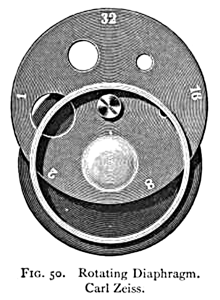
In optics, a diaphragm is a thin opaque structure with an opening (aperture) at its center. The role of the diaphragm is to stop the passage of light, except for the light passing through the aperture. Thus it is also called a stop. The diaphragm is placed in the light path of a lens or objective, and the size of the aperture regulates the amount of light that passes through the lens. The centre of the diaphragm's aperture coincides with the optical axis of the lens system.
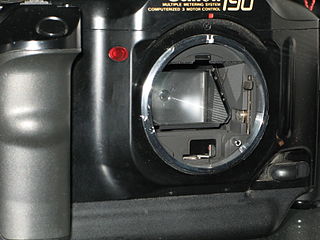
The Canon FD lens mount is a physical standard for connecting a photographic lens to a 35mm single-lens reflex camera body. The standard was developed by Canon of Japan and was introduced in March 1971 with the Canon F-1 camera. It served as the Canon SLR interchangeable lens mounting system until the 1987 introduction of the Canon EOS series cameras, which use the newer EF lens mount. The FD mount lingered through the release of the 1990 Canon T60, the last camera introduced in the FD system, and the end of the Canon New F-1 product cycle in 1992.

Within the field of photography, a toy camera is a simple, inexpensive film camera.
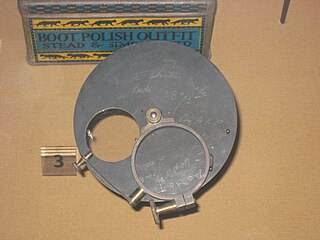
In photography, a shutter is a device that allows light to pass for a determined period, exposing photographic film or a photosensitive digital sensor to light in order to capture a permanent image of a scene. A shutter can also be used to allow pulses of light to pass outwards, as seen in a movie projector or a signal lamp. A shutter of variable speed is used to control exposure time of the film. The shutter is constructed so that it automatically closes after a certain required time interval. The speed of the shutter is controlled by a ring outside the camera, on which various timings are marked.
The following outline is provided as an overview of and topical guide to photography:

The Petzval objective or Petzval lens is the first photographic portrait objective lens in the history of photography. It was developed by the German-Hungarian mathematics professor Joseph Petzval in 1840 in Vienna, with technical advice provided by Peter Wilhelm Friedrich von Voigtländer. The Voigtländer company went on to build the first Petzval lens in 1840 on behalf of Petzval, whereupon it became known throughout Europe. Later, the optical instruments maker Carl Dietzler in Vienna also produced the Petzval lens.
The design of photographic lenses for use in still or cine cameras is intended to produce a lens that yields the most acceptable rendition of the subject being photographed within a range of constraints that include cost, weight and materials. For many other optical devices such as telescopes, microscopes and theodolites where the visual image is observed but often not recorded the design can often be significantly simpler than is the case in a camera where every image is captured on film or image sensor and can be subject to detailed scrutiny at a later stage. Photographic lenses also include those used in enlargers and projectors.

The invention of the camera in the early 19th century led to an array of lens designs intended for photography. The problems of photographic lens design, creating a lens for a task that would cover a large, flat image plane, were well known even before the invention of photography due to the development of lenses to work with the focal plane of the camera obscura.
